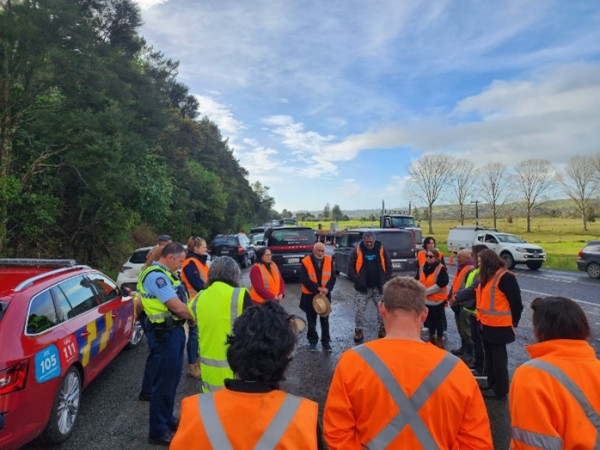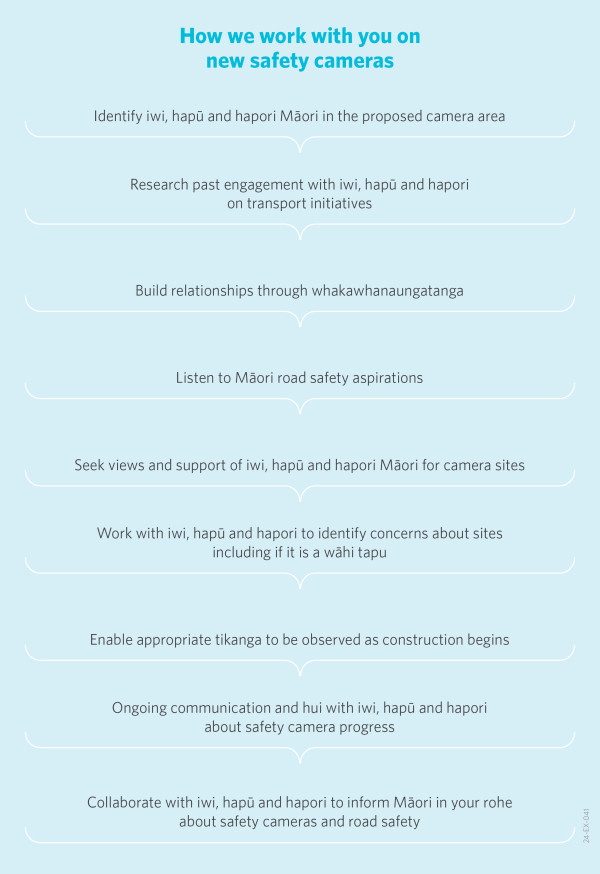
Blessing of safety camera site between Kawakawa and Moerewa in Tai Tokerau.
Safety cameras are located where they are most needed to keep whānau and hapori safe.
Statistics show Māori are disproportionately harmed by road crashes, making up 32% of casualties in fatal crashes where speed is a factor.
Overall, road traffic mortality rates are estimated at between 60% and 200% higher for Māori compared to non-Māori.
Safety cameras will help reduce deaths and serious injuries on our roads.
The cameras are a reminder to everyone to travel at safe speeds and make safe driving choices – so you and your whānau can get home safely.
When a crash happens, the speed you are travelling can be the difference between being killed, a life changing injury, and walking away unharmed.

How we work with you on new safety cameras [PDF, 19 KB]
We are increasing the number and type of safety cameras to reduce deaths and serious injuries on our roads, not to gather revenue.
Safety cameras remind everyone to do the right thing so whānau can get home safely.
You won’t have to pay any infringement fees if you travel within the speed limit.
When you enter a fixed safety camera area, signs will remind you to travel at safe speeds and respect red lights.
Waka Kotahi does not receive any funds from safety cameras. Infringement fees go into the Government Consolidated Fund.
When a safety camera detects a vehicle travelling up to 50 km/h over the speed limit we issue an infringement notice. Fees currently range from $30 to $630 depending on the speed detected.
You need to pay by the date on the infringement notice.
When a safety camera detects a vehicle speeding more than 50 km/h over the speed limit we issue a traffic offence notice.
As this is a serious offence, we may file charges in court. The court decides on the fine and/or penalty.
Safety cameras only detect speeding or red light offences, depending on the camera type.
Cameras capture things like vehicle speed, the date, time and place of the event, images of the vehicle, lane, and vehicle type.
Cameras are not collecting any other information or offences such as mobile phone or seatbelt use, warrant of fitness or vehicle registration.
Our systems have security measures in place to stop the loss, misuse and alteration of information. We keep information our safety cameras capture for up to seven years, depending on its type.
We only share data to process infringements or as required by law. Safety cameras also collect non-personal information for research and analysis of roading activity.
We know protection of data is a significant concern for Māori. Our safety camera Māori advisory group has expertise in data protection, which helps to ensure your concerns are reflected in our processes.
Māori Data Sovereignty recognises that Māori data should be subject to Māori governance. This will enable Māori to use the data to achieve aspirations such as improving road safety.
Our Māori advisory group has helped us to define Māori data as data produced by Māori, and data about Māori and the environments we have relationships with.
This definition has been endorsed by the Waka Kotahi Digital Executive Steering Committee.
We are working on how to apply this definition to data collected from safety cameras.
From July 2024, we’re starting to take over permanent cameras from NZ Police and we expect to complete the transfer of all permanent cameras to our network in 12 months.
We’ll take over the management and issuing of notices from 62 speed cameras from Police. Other Road Controlling Authorities (RCAs) will continue managing 47 red light cameras and we’ll issue the notices.
We’re also taking over responsibility for mobile cameras from police during 2025.
We’re working to ensure iwi near camera locations are aware that police cameras are transferring to us.
Taking over safety cameras from NZ Police